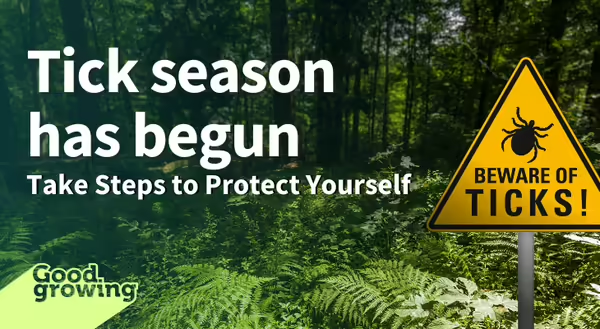
Ticks! I can’t stand these parasitic arachnids. I have had far too many run-ins with ticks throughout my life. They seem to find me every year. So far this spring I have found one lone star tick (Amblyomma americanum) attached to me and I have caught several other ticks headed my way looking for a bite to eat.
Fortunately, lone star ticks are not known to transmit Lyme disease, but there are plenty of other ailments they can impart to their human host. One such affliction is the dreaded alpha-gal syndrome that makes humans allergic to red meat.
Types of Tick
Ticks come in a variety of different species. In Illinois, our most common tick found feeding on our pets and humans is the American dog tick (Dermacentor variabilis). However, it is the infamous black-legged (deer) tick (Ixodes scapularis) that receives the most attention as the primary carrier of Lyme disease. During their first year of life, the tiny deer tick larva is only slightly larger than the period at the end of this sentence. Deer tick larva feeds primarily on white-footed field mice in their first year. The next spring, deer ticks molt into a slightly larger, pin-head-sized nymph, which feeds on various larger animals, including people. During the fall of the second year, deer ticks molt to adults and feed primarily on deer.
Although rare in Central Illinois, in areas where they are more prevalent, deer ticks are commonly found in the leaf litter on forest floors. This leaves hikers, campers, conservation workers, and gardeners more at risk of picking up a deer tick. Other species of ticks can be found in various habitats. I often encounter ticks in overgrown, weedy areas or prairie.
Tick Identification
Different species of ticks carry different types of human pathogens. Knowing the species of tick is critical to knowing potential disease risks. Though ticks are found throughout the United States, Northeastern US is often referred to as "Tick Country." There are several tick identification resources from institutions located this part of the country. The University of Rhode Island has useful online tick field guide called TickEncounter.
Protect Yourself from Ticks
If you are headed outside to a location suitable for ticks, there are ways to protect yourself.
- First is to avoid weedy areas, prairies, or the woods. However, this is not an option for those who work in these environments.
- Wear long pants with the cuffs tucked into your socks. Don’t worry this look is in vogue in tick country.
- Apply an insect repellent containing DEET to socks, pants, boots, and exposed skin areas.
- Walk in the center of trails to avoid brushing up against vegetation.
- Wear a hat.
- Ticks are dark colored. Therefore, wear light-colored clothing so they stand out and can be easily removed.
- When working or hiking in the woods or brush, occasionally stop to do a quick group tick check.
- At home do a thorough inspection for any ticks that may have found their way under your clothing or in your hair.
- Shower, shampoo and do another check of the entire body.
- Wash clothes immediately in hot water.
Removing a Tick
If you or your ‘tick buddy’ spots a tick attached to you, remove it with tweezers. Grasp the tick with the tweezers as close to the head as possible and pull straight off. Do not use a lighted match, twist, or apply gasoline to a feeding tick. These home remedies can often cause more harm and increase the chance of infection.
Immediately wash the bite. Monitor the site for any secondary infection. If symptoms of illness and unexplained rash develop along with a fever, contact your physician.
Tick-borne Diseases
As mentioned, ticks carry more than just Lyme disease. If you are bitten, knowing the species will clue you into possible disease risks. Ticks must bite and begin to take a blood meal for a certain amount of time to transmit disease. According to the Centers for Disease Control (CDC), ticks must feed for 24 to 36 hours to transmit Lyme disease. Different diseases may have a different amount of time it takes to transmit the disease. If you find a tick attached, remove it and seal it in a plastic bag or container in case a doctor would want to submit it for testing. The best thing to do in the event of a tick bite is to consult a physician.
Good Growing Tip of the Week: You can buy pretreated clothing that kills ticks crawling on you. If you’re not crazy about insecticide on your skin, there are also pretreated tick ankle bands that wrap around the outside of clothing on your lower leg.
Additional Resources
Tick Research Lab of Pennsylvania
Illinois Department of Public Health - Tick ID
Sign up for our emails! Want to get notified when new Good Growing posts are available? SIGN ME UP
Give us feedback! How helpful was this information (click one): Very helpful | Somewhat helpful | Not very helpful
MEET THE AUTHOR
Chris Enroth is a horticulture educator with University of Illinois Extension, serving Henderson, McDonough, Knox, and Warren counties since 2012. Chris provides horticulture programming with an emphasis on the home gardener, landscape maintenance personnel, and commercial landscapers. Additional responsibilities include coordinating local county Master Gardener and Master Naturalist volunteers - providing their training, continuing education, advanced training, seasonal events, and organizing community outreach programs for horticulture and conservation assistance/education. In his spare time, Chris enjoys the outdoors, lounging in the garden among the flowers (weeds to most).